

Watercolor Lesson: How to Paint Cat Eyes - Artist's Network. If you love everything about art, including learning new styles, looking at the work of others, and being inspired by the enthusiasm of other artists, then I have the book for you.
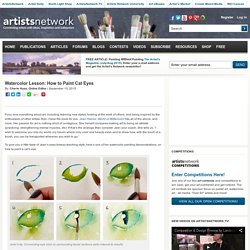
Jean Haines’ World of Watercolor has all of the above, and more. Her passion for art is nothing short of contagious. She herself compares making art to being an athlete (practicing, strengthening mental muscles, etc). If that’s the analogy, then consider Jean your coach. She tells us, “I wish to welcome you into my world–my haven where only color and beauty exist–and to show how, with the touch of a brush, you can be transported wherever you wish to go.” To give you a little taste of Jean’s easy-breezy teaching style, here’s one of her watercolor painting demonstrations, on how to paint a cat’s eye. Jean’s tip: Connecting eye color to surrounding facial sections adds interest to results. I love painting animals. 1. 2. 3. 4. 5. 6. Painting with Gravity. Beyond the Brush: Inventive Use of Media for Painting Students. Dreamscaping With June Rollins® When teaching watercolor classes, I often see students struggle with what I consider one of the joys of watercolor.
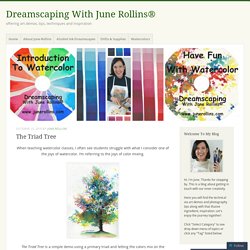
I’m referring to the joys of color mixing. The Triad Tree is a simple demo using a primary triad and letting the colors mix on the paper. Above is the painting set-up. I’m using American Journey Joe’s Blue, Sour Lemon and Pomegranate. Mist the paper first and then tap in yellow. Next, tap in red. Next, blue. All three colors have been tapped in.
Bring out the mister and pull the trigger! Hot Glue Gun Stencils. Instead of art journal prompts this week I’m experimenting with some art journaling techniques!
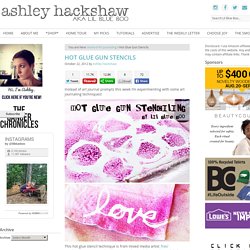
This hot glue stencil technique is from mixed media artist Traci Bautista…..my art journaling hero. I’m in love with her studio…..click the image below to see more: First, I used my hot glue gun to draw out a few designs. Tutorials. P.S.
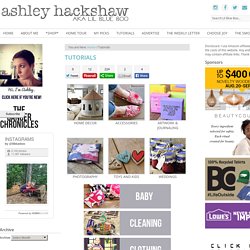
Make sure to sign up for my weekly newsletter. …it’s where I give my weekly rundown. Glazed, Distressed Paintings. I was so excited when Kirstin and Jordan of Kojo Designs asked me to be a part of their “the sincerest form of flattery” series!

I love a good challenge so I’ve been keeping my eye out for something on my “wish list” that would be fun to do! I love these prints of glazed paintings from Ballard Designs and decided to make a miniature version of the beach themed one: With a few simple steps (and an eager toddler), I was able to mimic a similar glazed effect to create my own beach painting! Alma Stoller: how to make a cardboard canvas. Supplies: cardboard/chipboard, mod podge, masking tape, a brush and pages from a book. apply Mod Podge on a piece of cardboard and collage book pages on it.
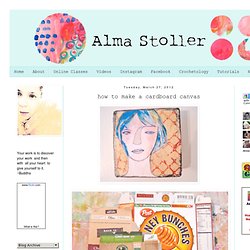
Let it dry cut a 4 inch square and 4 strips that are 1 1/2 inches wide use masking tape the adhere the strips to the square. add snippets of tape on the inside of the canvas. until it looks like this... then collage snippets of book pages on and inside the canvas in order to cover up the masking tape. when you are done, it should look something like this. done! Now, it is ready for you to paint or collage on it. check out the other tutorials by STITCHED instructors: How to Make Your Own Fluid Acrylics. Video Tutorials Using the Gelli Plate. On the 1st of each month I’ll have a new Gelli video tutorial!
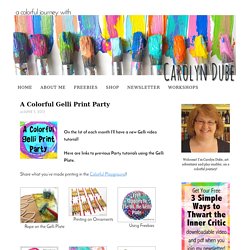
Here are links to previous Party tutorials using the Gelli Plate. Share what you’ve made printing in the Colorful Playground! Be sure to check out the Colorful Playground for some amazing prints, projects, and techniques! Come and share what you’re making on the Gelli Plate in the Colorful Playground Google+ community! Are you new to Google+ and wonder how it all works? Free Doodle Tutorial: Doodling & Mixed Media Techniques. Who says a bouquet can’t be fodder for a little graffiti fun?

Traci Bautista is back, bringing you yet another great collage tutorial —a technique that you can try in your art journal the next time you are stumped for ideas. This same technique could be used on fabric, where doodling is just as much fun as it is on paper. (And if you’ve wanted to start an art journal, but haven’t yet, we can help you decide what type of journal is best for you.) (This tutorial was previously published in Doodles Unleashed by Traci Bautista, copyright 2012; republished here courtesy of CreateMixedMedia.com) Inspired by the juxtaposition of colorful urban graffiti walls and blossoming gardens, my graffiti bouquet paintings are visual journal collages with extreme color and texture in rich, vibrant layers. Spread gesso onto the page with a foam brush. Paint over flower shapes and stems with acrylic paints.
Paint the stems and leaves in darker acrylic paints using a flat brush. Let the piece dry. Acrylic Leaf Printing: A Watercolor Tutorial for Art Journaling - Create Mixed Media. While this tutorial encourages the use of loose watercolor paper, you can, of course, try this technique in your art journal so long as it’s on watercolor paper.
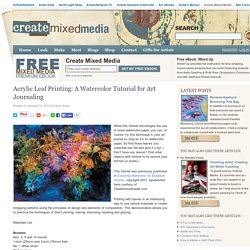
So find those leaves you collected last fall and give it a try! ( Don’t have any leaves? Find other objects with texture to try around your kitchen or studio.) This tutorial was previously published in Exploring Watercolor by Elizabeth Groves, copyright 2007; republished here courtesy of Createmixedmedia.com. Printing with leaves is an interesting way to use natural materials to create intriguing patterns using the principles of design and elements of composition. Painting with Re-Inkers from Wabi-Sabi Art Workshop - Create Mixed Media. (This tutorial was previously published in the book Wabi-Sabi Art Workshop by Serena Barton, copyright 2013; republished here courtesy of CreateMixedMedia.com.)
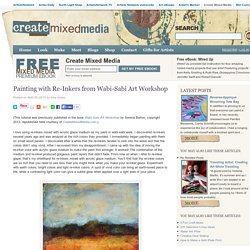
I love using re-inkers mixed with acrylic glaze medium as my paint in wabi-sabi work. I discovered re-inkers several years ago and was amazed at the rich colors they provided. I immediately began painting with them on small wood panels. Creating Backgrounds from Mixed Media Techniques for Art Journaling - Create Mixed Media. Creating backgrounds can be one of the funnest parts of art journaling and in Mixed Media Techniques for Art Journaling, you can learn some awesome background-making techniques.
Below are some of the Groovy Backgrounds from Journal Bliss by Violette that are featured in Mixed Media Techniques for Art Journaling. But that’s not quite enough, is it? Scroll down a bit further to find some “Fear No Color” background techniques from Acrylic Techniques in Mixed Media by Roxanne Padgett! Groovy Backgrounds from Mixed Media Techniques for Art Journaling. Anatomically Speaking from Collage Crafts Gone Wild - Create Mixed Media. This tutorial was originally published in Bent, Bound and Stitched by Gieseppina “Josie” Cirinione. It was republished in the book Collage Crafts Gone Wild: Mixed-Media Projects and Techniques edited by Kristy Conlin, copyright 2013; featured here courtesy of CreateMixedMedia.com.
Clip art and decorative paper can come together strikingly through the modern marvels of photocopy technology. By photocopying clip art onto scrapbook paper or pages of a dictionary, you add instant dimension to any image. Try the same technique with a black-and-white photograph. Mistakes Can Be an Opportunity - Create Mixed Media. I used to be afraid that I might make a mistake but not any more. Mistakes are pure gold to me now. Why? Because every mistake is an opportunity. Things formerly known as a mistake are now just an Oops. In this video, you will see my Oops as I play with stencils from StencilGirl and and paint on a large envelope. Mixed Media on Paper - Create Mixed Media. *A guest post by Jenny Moed-Korpela. “Use your journal as a space where failure doesn’t exist; play and experiment to your heart’s content.” I really enjoy mixed media because of the texture and the layering it allows you to do.
I love using book pages and song sheets behind my birds, it gives them something poetic, and shows a bit of my own history and story. Acrylic Painting Outside the Square! - Create Mixed Media. (This tutorial was previously published in the book Paint Mojo A Mixed Media Workshop by Tracy Verdugo, copyright 2014. It is republished here courtesy of North Light Books and CreateMixedMedia.com.)
The grid is a representation of the Western way of thinking, where everything has to be “just so,” rigid and compartmentalized. Balzer Designs. 25 Key Watercolor Painting Tutorials, Techniques, How Tos. Techniques with Water Soluble Media - Faber-Castell Design Memory Craft. Creating Watercolor Textures with Alcohol. The Art of Acrylics: Creative Painting Techniques.
Salt + coffee watercolor technique. I’ve been painting ever since I was little, but somehow, watercolors never remained in my rotation for very long. It’s a shame because watercolor techniques can produce beautiful painterly effects, and some of my favorite artists these days work in the medium. Luckily, this watercolor tutorial from Michelle requires no previous experience; it uses simple household materials like coffee and salt to create cool visual effects in the application of the paint. Not only are you learning how to make an original piece of art, but you can also use Michelle’s technique to give maps, prints and paper of all kinds an unusual, antique look. Thanks for sharing, Michelle! — Kate Read the full how-to after the jump! Art Journal Every Day: No More Blank Pages. Mixed Media Techniques. Mixed Media Techniques.